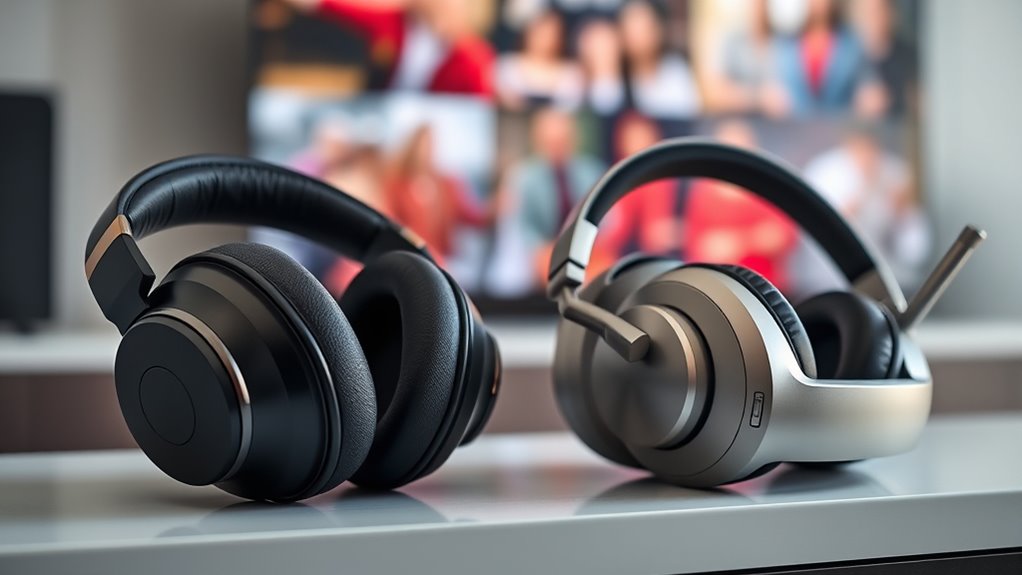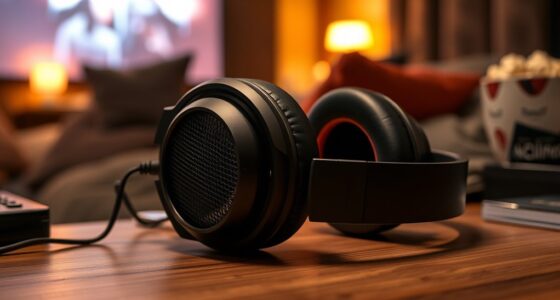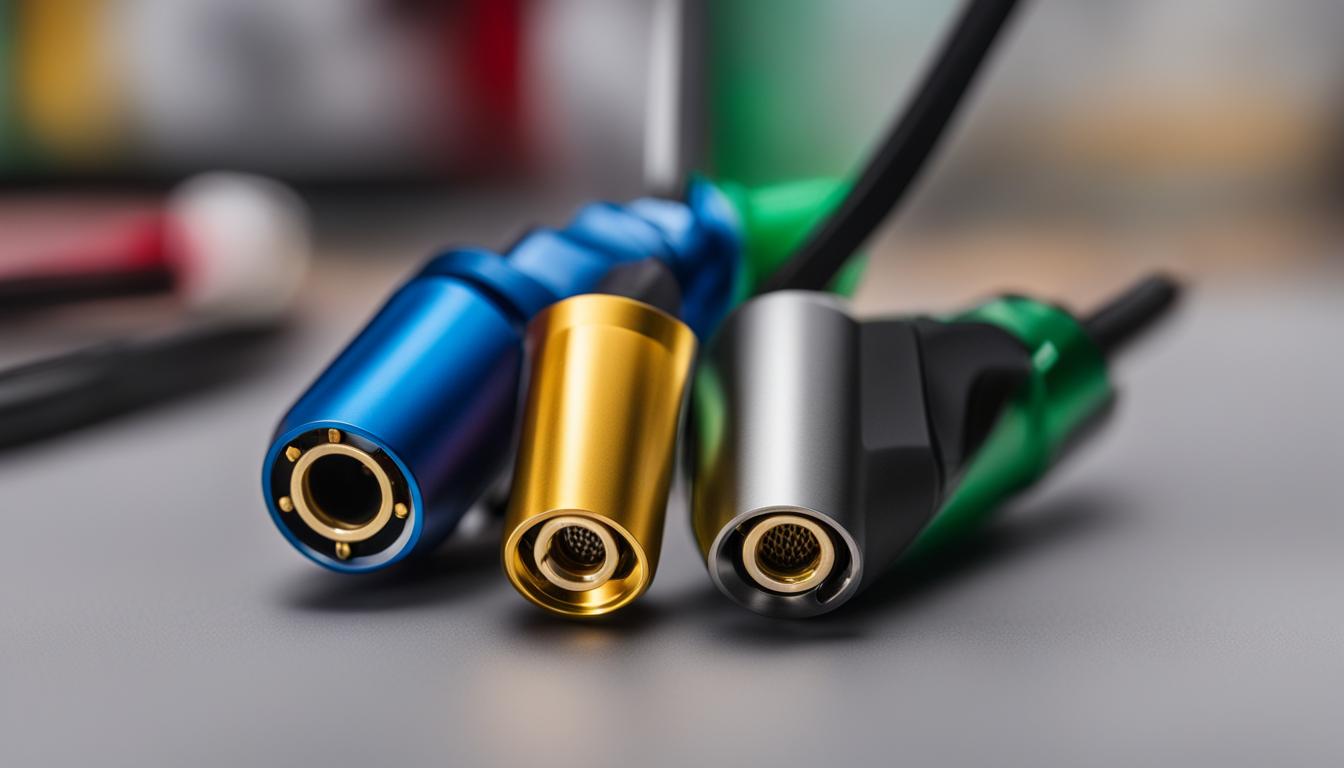If you’re choosing between Bluetooth and RF headphones for TV and movies, consider your needs for range, sound quality, and convenience. Bluetooth headphones are easy to connect and portable but can have some audio lag, which might disrupt watching. RF headphones offer a more stable connection and longer range, ideal for large rooms, but are less portable. To find out which option suits your setup best, explore the details further below.
Key Takeaways
- RF headphones generally offer more stable, lower-latency audio ideal for watching movies, while Bluetooth may introduce noticeable delay.
- RF systems provide a longer range and better signal reliability for TV viewing in larger rooms or from a distance.
- Bluetooth headphones are more portable, easier to connect, and suitable for casual TV listening, but may have slight audio lag.
- RF headphones require a dedicated transmitter and are less portable, making them better for fixed setups.
- For high-quality, stable audio with minimal lag during movies, RF headphones are typically the better choice.

When choosing between Bluetooth and RF headphones, understanding their differences can help you make an informed decision. Both types connect wirelessly, but they do so in different ways, which impacts their performance, range, and suitability for watching TV and movies. Bluetooth headphones use a short-range wireless connection that pairs with your device via radio frequency within a limited distance, typically around 30 feet. RF headphones, on the other hand, transmit audio through a dedicated radio frequency signal from a base station or transmitter to the headphones, often offering a longer range of up to 100 feet or more. Additionally, RF systems often utilize specific radio frequency bands to optimize signal clarity and reduce interference.
Bluetooth and RF headphones connect wirelessly but differ in range, performance, and compatibility for TV and movies.
If you prioritize convenience and compatibility, Bluetooth headphones are generally the better choice. They work seamlessly with most modern TVs, smartphones, tablets, and computers, thanks to built-in Bluetooth technology. You can easily pair them with multiple devices and switch between them without much hassle. However, Bluetooth can sometimes introduce latency—audio delay—that might be noticeable when watching movies or playing games. This lag can cause the sound to be out of sync with the visuals, which can be distracting, especially during dialogue-heavy scenes. Also, Bluetooth audio quality has improved over time, making it a more viable option for high-quality sound.
RF headphones are designed specifically for audio transmission, often providing a more stable and reliable connection over longer distances. Because they use a dedicated radio frequency signal, they usually experience less interference and latency than Bluetooth. This makes RF headphones particularly appealing for watching TV from a distance or in larger rooms where you can sit far from the source device. The base station or transmitter typically connects directly to your TV via an audio cable, and the headphones pick up the signal without needing to be paired each time. This setup is especially advantageous if you want a consistent, high-quality audio experience without interruptions.
However, RF headphones can be less convenient when it comes to compatibility. They usually require a dedicated transmitter, which might not be built into your TV and could need an additional purchase or setup. Plus, RF headphones tend to be bulkier and less portable than Bluetooth models, making them more suited for stationary use rather than active or on-the-go listening. For those seeking a wireless audio solution that balances ease of use and performance, RF systems are often the better choice.
In the end, your choice depends on your specific needs. If you want simple, quick pairing and device versatility, Bluetooth is often more convenient, but be prepared for potential latency issues. If you’re seeking a longer range, minimal delay, and a more stable connection for watching TV from across the room, RF headphones are likely the better fit. Understanding these differences helps you select the option that best enhances your TV and movie experience.
Frequently Asked Questions
Are Bluetooth Headphones Suitable for Outdoor Use With TVS?
You’re wondering if Bluetooth headphones work well outdoors with your TV. Bluetooth headphones are portable and convenient, making them suitable for outdoor use. However, their range can be limited, usually around 30 feet, and they may face interference from other wireless devices or obstacles. For outdoor TV use, make certain your Bluetooth headphones have a strong connection and consider using models with longer ranges or low latency features for better experience.
Can RF Headphones Cause Audio Delay Issues?
You might worry about audio delay with RF headphones, but they’re generally designed to minimize latency, making delays less noticeable than with Bluetooth. Unlike Bluetooth, which can sometimes cause lip-sync issues, RF headphones often offer a more synchronized experience, especially for TV and movies. So, while delays are possible, choosing high-quality RF headphones usually means you’ll enjoy near real-time audio without frustrating lag.
Which Headphones Have Better Battery Life for Long Movie Sessions?
For long movie sessions, you want headphones with excellent battery life. Generally, RF headphones tend to last longer—often 15 to 20 hours—giving you plenty of uninterrupted viewing. Bluetooth models usually offer around 8 to 12 hours, which might require charging mid-movie. So, if you’re planning extended sessions, RF headphones are a smarter choice. Just make sure they’re comfortable and compatible with your TV for the best experience.
Do Bluetooth Headphones Interfere With Other Wireless Devices?
They say, “Where there’s smoke, there’s fire,” but with Bluetooth headphones, interference isn’t always unavoidable. Usually, Bluetooth signals are strong enough to avoid crossing paths with other wireless devices, especially if you’re within a reasonable distance. However, in crowded environments with many signals, you might experience some interference or dropouts. To minimize this, keep your headphones and other devices a bit apart and make sure your Bluetooth is up-to-date.
Are RF Headphones Safe for Extended Listening Periods?
RF headphones are generally safe for extended listening, but it’s smart to take breaks to protect your ears. They emit radio frequency signals, which are non-ionizing and considered safe at typical usage levels. However, prolonged exposure at high power levels might cause some discomfort or minor health concerns. To stay safe, limit continuous use, keep the volume moderate, and follow the manufacturer’s guidelines.
Conclusion
So, which headphones are right for you—Bluetooth or RF? It really depends on your needs: do you prioritize convenience and compatibility, or do you want the best possible sound quality and minimal lag? Think about your setup and what matters most during your TV and movie time. Ultimately, isn’t enjoying your favorite shows without interruptions or hassle what truly matters? Choose the one that keeps your entertainment seamless and enjoyable.














